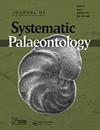The earliest chimaeriform fish from the Carboniferous of Central Russia
IF 2.2
2区 地球科学
Q3 EVOLUTIONARY BIOLOGY
引用次数: 1
Abstract
The ancestry of chimaeriform chondrichthyan fishes can be traced back to the Late Triassic (∼220 Ma). To date, only one chimaeriform suborder, the Echinochimaeroidei, has been recognized from the Palaeozoic. The origin and evolution of the chimaeriforms has been a matter of debate for more than a hundred years. This problem is aggravated by the scarcity of holomorphic fossils; the bulk of the material includes only hard parts of the jaw apparatus and other skeletal elements. Here we describe the oldest record of the Chimaeriformes, represented by tooth plates from the lower Carboniferous deposits (∼338–332 Ma) of Russia, as Protochimaera mirabilis gen. et sp. nov., and establish a new family and suborder based upon their particular morphological and histological features. The newly described tooth plates demonstrate a continuous layer of varitubate dentine over their oral surfaces; beak-shaped mandibular plates have been formed by fusion of a labial component of cutaneous origin to two others formed orally. Three separate vascular systems enabled the growth of these histological components. The beak and wear facets suggest a grasping-cutting feeding action and are the earliest example of this feeding mode in fishes after the placoderm extinction at the end of the Devonian. Phylogenetic analysis of the dental characters places these stem chimaeriforms as a sister group to the Chimaeroidei. http://zoobank.org/urn:lsid:zoobank.org:pub:urn:lsid:zoobank.org:pub:5593C7FE-B5B5-4922-8D32-BF0440D89192俄罗斯中部石炭纪最早的嵌合体鱼
嵌合体软骨鱼类的祖先可以追溯到三叠纪晚期(~220 马)。到目前为止,只有一个嵌合体亚目,棘嵌合体,从古生代就被发现了。黑猩猩的起源和进化已经争论了一百多年。全纯化石的稀缺加剧了这个问题;大部分材料仅包括颌装置的硬质部分和其他骨骼元件。在这里,我们描述了Chimaeriformes最古老的记录,以下石炭系沉积物的齿板为代表(~338–332 Ma),命名为奇异原嵌合体gen.et sp.nov.,并根据其特殊的形态和组织学特征建立了一个新的科和亚目。新描述的牙板在其口腔表面上显示出一层连续的变管状牙本质;喙形下颌板是通过将皮肤来源的唇侧成分与口腔形成的另外两个成分融合而形成的。三个独立的血管系统使这些组织学成分得以生长。喙和磨损面表明了一种抓取-切割的进食行为,是泥盆纪末盾形目灭绝后鱼类这种进食模式的最早例子。牙齿特征的系统发育分析将这些茎嵌合体作为嵌合体的姐妹群。http://zoobank.org/urn:lsid:zoobank.org:pub:urn:lsid:zoobank.org:pub:5593C7FE-B5B5-4922-8D32-BF0440D89192
本文章由计算机程序翻译,如有差异,请以英文原文为准。
求助全文
约1分钟内获得全文
求助全文
来源期刊
CiteScore
5.30
自引率
7.70%
发文量
31
审稿时长
>12 weeks
期刊介绍:
The Journal of Systematic Palaeontology publishes papers that provide novel and impactful results in phylogenetics and systematics and that use these results in ways that significantly advance rigorous analyses of palaeogeography, palaeobiology, functional morphology, palaeoecology or biostratigraphy. Papers dealing with theoretical issues or molecular phylogenetics are also considered if they are of relevance to palaeo-systematists. Contributions that include substantial anatomical descriptions, descriptions of new taxa or taxonomic revisions are welcome, but must also include a substantial systematics component, such as a new phylogeny or a revised higher-level classification. Papers dealing primarily with alpha-taxonomic descriptions, the presentation of new faunal/floristic records or minor revisions to species- or genus-level classifications do not fall within the remit of the journal.

 求助内容:
求助内容: 应助结果提醒方式:
应助结果提醒方式:


